Posts Tagged ‘bad movies’
Skyline




Skyline, this company, is a low-budget breath of fresh air. In today’s Hollywood, where filmmakers routinely spend $100 million dollars only to make a really crappy movie, it’s good to know that for a tenth of that, they can make one just as bad.
Somewhere in Southern California, after a viewing of Cloverfield, I figure the two Strause brothers (aka, “The Brothers Strause”) turned to each other and said something like:
“Dude! Instead of music videos, we should make a Cloverfield movie–but about aliens!”
“Dude, you’re right! Kinda like Independence Day!”
“And The Matrix!”
“With stuff like from Aliens!”
“Dude!!”
Too bad it didn’t occur to them to use the good parts from those movies.
Plot Summary: Our heroic couple, Jarrod (Eric Balfour) and Elaine (Scottie Thompson) arrive in L.A. to visit their rich friend Terry (no relation to me), played by Scrubs alum Donald Faison. They all get eaten.
 The Story: Skyline has a terrific opening. Eschewing Hollywood’s trend of starting with a ton of backstory, it jumps right into action, suspense, and Scottie Thompson wandering around in her underwear. For about three minutes, that is. Then comes the “Fifteen hours earlier” flashback with a ton of backstory.
The Story: Skyline has a terrific opening. Eschewing Hollywood’s trend of starting with a ton of backstory, it jumps right into action, suspense, and Scottie Thompson wandering around in her underwear. For about three minutes, that is. Then comes the “Fifteen hours earlier” flashback with a ton of backstory.
The flashback begins with Jarrod and Elaine landing in L.A. to visit Jarrod’s old pal Terry. Elaine complains of being nauseated, probably because she just finished reading the script. They’re picked up by a limo and scooted away to a flat of luxury condos, where Terry lives in the penthouse with his bevy of babes and sycophants. Terry has made it big doing something with robots of some kind. Or maybe music. Or drugs. I’m not really sure, but the point is, he’s rich. He wants Jarrod to move out to L.A., but Jarrod isn’t so sure, especially after Elaine pulls that tired old, “Hey, I’m pregnant” gambit on him.
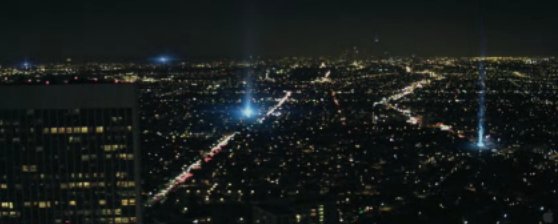
After a day of living the L.A. lifestyle of responsible drinking and low-key partying, the friends and sycophants pass out in Terry’s apartment. At 4:27 a.m., mysterious lights appear through the blinds. Ray, aka Sycophant #1, gazes at the lights and a special effect from the X-files suddenly crawls over his face. He opens the door to the balcony and disappears, to the horror of Sycophant #2 (Denise) to whom he must have owed money or something, because otherwise, I didn’t see a problem.
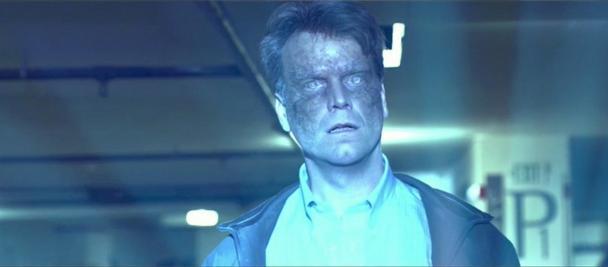
Denise’s screaming causes Jarrod and Elaine to meander into the mis-named “living room” to see what’s up. Jarrod nearly succumbs to the same special effect as Ray, but is pulled away from the light just in time. Clearly, however, he is infected, which would have foreshadowed something of great plot significance if either of the Brothers Strause had attended film school.
The lights disappear and, this being L.A., everyone in the city goes back to their sex, drugs, and rock and roll.
The next day dawns, and since the U.S. military and FEMA are nowhere in sight, everyone is caught off-guard when the lights return! Jarrod and Terry go up to the roof, armed with a Baretta 9mm (no doubt legally registered), to confront the situation. Alien ships descend from the sky and like airborne 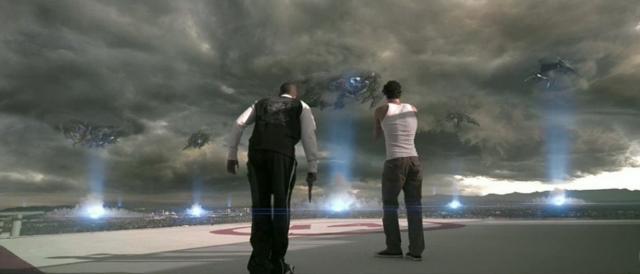 Roombas start vacuuming up residents. Jarrod and Terry escape from the roof with Elaine’s help–but she gazes into the light and is also infected. This, too, would lead to great repercussions later had the Brothers Strause known anything about film making.
Roombas start vacuuming up residents. Jarrod and Terry escape from the roof with Elaine’s help–but she gazes into the light and is also infected. This, too, would lead to great repercussions later had the Brothers Strause known anything about film making.
Our heroes return to the penthouse and decide the safest course of action would be to abandon the giant concrete structure they’re in and flee across open ground to the marina, where they can spend the morning finding a boat, getting it started, and scooting out onto the water where it’s just gotta be safe. Plus, the girls can work on their tans.
Announcing to his girlfriend, Candice, that he “has everything under control,” Terry rushes over to an elderly neighbor’s apartment to either save him or steal his car–it was a bit ambiguous. An alien ship that has escaped from the Matrix attacks them, and the neighbor’s stupid little yap dog gets himself and his kindly owner killed. (Yet another reason not to own a dog.)
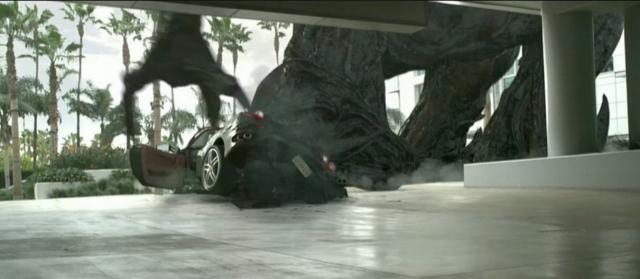 Terry rushes back to the penthouse where he discovers his girlfriend Candice has found pictures of him and Suckophant, er, Sycophant #2 gettin’ all jiggy wit’ it. Since the world’s ending and all, they put the discussion on hold and the gang makes their way to the parking garage. Terry hops in his Ferrari F430 Spider and leads the convoy to the exit. Given that alien hover ships are sucking people up off the street I would have put the top up, but that’s just me.
Terry rushes back to the penthouse where he discovers his girlfriend Candice has found pictures of him and Suckophant, er, Sycophant #2 gettin’ all jiggy wit’ it. Since the world’s ending and all, they put the discussion on hold and the gang makes their way to the parking garage. Terry hops in his Ferrari F430 Spider and leads the convoy to the exit. Given that alien hover ships are sucking people up off the street I would have put the top up, but that’s just me.
However, turns out not to make a hell of a lot of difference as a giant alien transformer monster creature is awaiting just such a foolish move. It stomps the car into a CGI pancake as soon is it clears the entrance, instantly killing Sycophant #2. Before Terry can escape, he is grabbed by the alien’s giant Japanese tentacle appendages and sucked into oblivion in the creature’s maw. Candice is still pissed about the pictures, though.
This stream of events leads the survivors to reconsider their escape plan, and they rush back up to the penthouse with the help of the building superintendent, Oliver.
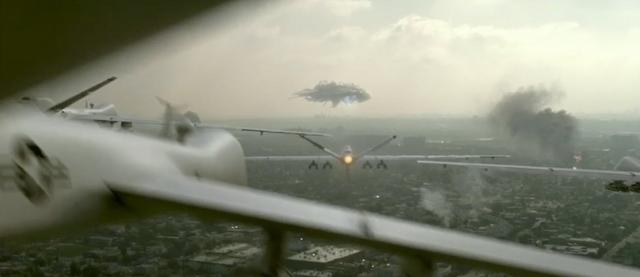 By now, someone at NORAD has figured out something is amiss and launches a massive airstrike of Unmanned Aerial Vehicles (UAVs), since the Obama administration has eliminated funding for our manned fighters. A UAV fires a missile at one of the hovering motherships. The missile goes directly into the ship’s thermal exhaust port and detonates in a massive mushroom cloud of thermonuclear death. The ship crashes into the ground, showing that mankind has a fighting chance. Until it rises back up and begins reassembling itself, showing that mankind is doomed.
By now, someone at NORAD has figured out something is amiss and launches a massive airstrike of Unmanned Aerial Vehicles (UAVs), since the Obama administration has eliminated funding for our manned fighters. A UAV fires a missile at one of the hovering motherships. The missile goes directly into the ship’s thermal exhaust port and detonates in a massive mushroom cloud of thermonuclear death. The ship crashes into the ground, showing that mankind has a fighting chance. Until it rises back up and begins reassembling itself, showing that mankind is doomed.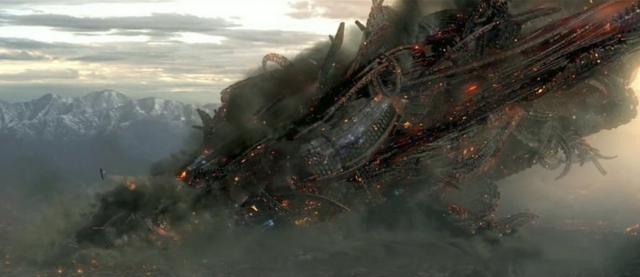
Our heroes are faced with a conundrum: choose between certain, horrible death in the street or stay in an apartment building full of food and drinks and places to hide. They decide to try escaping again.
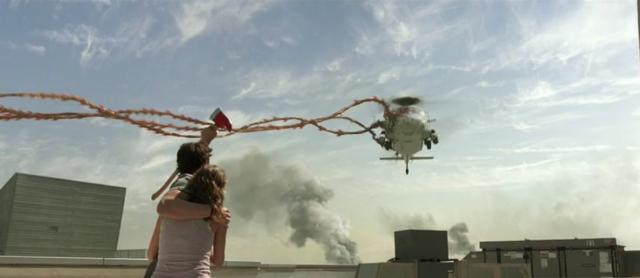 At this point the Army rapid deployment forces show up, a scant day or so after the invasion. Helicopters drop snipers armed with .50 caliber rifles and shoulder-mounted rockets. Jarrod and Elaine leave Oliver and Candice and rush to the roof to call for help. This, of course, alerts the aliens to the presence of the squad, and they promptly descend on the roof and start scarfing up soldiers like a bunch of camouflaged chiclets. Having never seen Cloverfield, Jarrod and Elaine wave to a passing helicopter to come rescue them. Alerted now to the helicopter’s presence as well, an alien fires his Japanese anteater-like tentacle tongue and destroys it, since someone forgot to provide air support.
At this point the Army rapid deployment forces show up, a scant day or so after the invasion. Helicopters drop snipers armed with .50 caliber rifles and shoulder-mounted rockets. Jarrod and Elaine leave Oliver and Candice and rush to the roof to call for help. This, of course, alerts the aliens to the presence of the squad, and they promptly descend on the roof and start scarfing up soldiers like a bunch of camouflaged chiclets. Having never seen Cloverfield, Jarrod and Elaine wave to a passing helicopter to come rescue them. Alerted now to the helicopter’s presence as well, an alien fires his Japanese anteater-like tentacle tongue and destroys it, since someone forgot to provide air support.
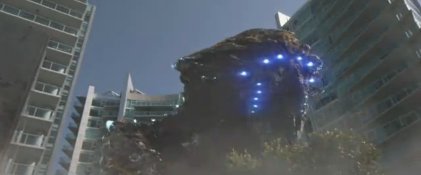 Aliens now roam the streets of L.A., sucking up stragglers with their tentacles. (“Dude, War of the Worlds!”) The critters have glowing LED eyeballs, subtly displaying the Brothers’ Strause environmental awareness. One of them leaps onto the roof and attacks Jarrod (an alien, not a Brother Strause). Elaine swoops in from behind it and kills it with an ax. But before they can escape, it comes back to life and jumps on Elaine, screeching “Who’s your boyfriend now?” in its native language. Jarrod attacks the creature with a concrete block and kills it. Instead of using million-dollar nukes, Stinger missiles, and UAVs, the Department of Defense should have just rolled some trucks into Home Depot, picked up same day laborers and bricks, and gone medieval on the aliens’ ass.
Aliens now roam the streets of L.A., sucking up stragglers with their tentacles. (“Dude, War of the Worlds!”) The critters have glowing LED eyeballs, subtly displaying the Brothers’ Strause environmental awareness. One of them leaps onto the roof and attacks Jarrod (an alien, not a Brother Strause). Elaine swoops in from behind it and kills it with an ax. But before they can escape, it comes back to life and jumps on Elaine, screeching “Who’s your boyfriend now?” in its native language. Jarrod attacks the creature with a concrete block and kills it. Instead of using million-dollar nukes, Stinger missiles, and UAVs, the Department of Defense should have just rolled some trucks into Home Depot, picked up same day laborers and bricks, and gone medieval on the aliens’ ass. 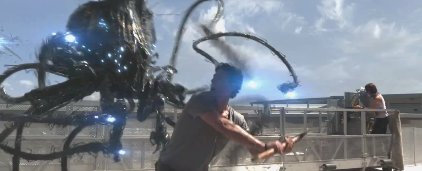
Back in the abandoned penthouse, Oliver and Candice are busy surviving by not going outside. Candice finds the telescope Terry uses for spying on his gay neighbors and watches everything unfold over the city, sadly forgetting that looking at the aliens causes you to get possessed. Oops. She walks out onto the balcony and lets herself get sucked up (and not in the good way). Oliver realizes all is lost and turns on the gas (gas?) in the penthouse and within seconds has flooded it to exactly combustion mixture. He then puts a hollow cigarette in his mouth (don’t ask me), picks up his lighter and waits. An alien floats into his room and he suavely clicks the lighter, which doesn’t work.
By this time, I’m fully on the aliens’ side, since none of these people deserve to live.
Oliver struggles with the creature, regains his lighter, and divining that it will now function, looks the creature in the LEDs and says, “Via con Dios,” which is superintendent for “Yippie ki yay, mother–” and clicks his Bic. The penthouse explodes, killing Oliver and probably not hurting the creature at all since a gas explosion is significantly cooler than a nuclear detonation.
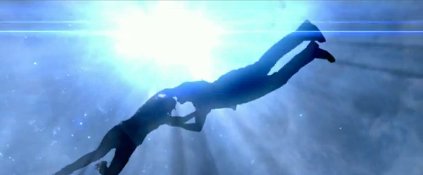 Meanwhile on the roof, Jarrod and Elaine know the game is up. Surrendering to the inevitable, they allow themselves to be sucked up to a mothership. As they disappear into the light, they share one last kiss, conveying the message that love is eternal and can never truly die. The screen fades to white and the movie is over. And none too soon, since there was no way the Brothers Strause could possibly have made anything stupider.
Meanwhile on the roof, Jarrod and Elaine know the game is up. Surrendering to the inevitable, they allow themselves to be sucked up to a mothership. As they disappear into the light, they share one last kiss, conveying the message that love is eternal and can never truly die. The screen fades to white and the movie is over. And none too soon, since there was no way the Brothers Strause could possibly have made anything stupider.
Then the white screen faded into the next scene.
We’re now in the bowels of the alien ship, where Elaine awakens in a dark, nasty tomb filled with debris and other humans. Alien tentacle creatures are floating around, popping the heads off people and pulling out their glowing (?) brain stem, Pez-style. Elaine sees one pick up Jarrod, who awakens, defeats the creature and makes good their escape.
Ha ha. Not really. The creature pulls off Jarrod’s head, sucks out his intact brain, and puts it into its own body.
Naturally, Elaine finds this a mite disturbing and screams. Another critter grabs her, starts to pop off her head but then . . . it sends a tentacle probing over her body (“I’m not touching you!”). It finds the baby! Well, it can’t very well kill her now. (Note: if you’re a pregnant woman captured by decapitating, brain-eating aliens, hope they’re pro-life.)
So the creature drops her, but then it or maybe another one climbs on top of her or maybe threatens to do something, I dunno, but she screams again alerting–
The alien that took Jarrod’s brain! (A much better title than Skyline, by the way.)
It rushes to her aid, beats the living snot out of the creature threatening her, then looms over her, running its clawed tentacle tenderly over her face. Terrified at first, Elaine then gazes longingly into the hideous creature’s love-filled LEDs and whispers, “Jarrod?”
And presumably they lived happily ever after. Not counting the lifetime of horrible nightmares of this entire experience, that is.
I’m talking about mine, not Elaine’s.
All Rights Reserved
The Last Airbender




The Last Airbender is terrific! Tremendous character depth; intensely personal, believable conflicts; the timeless moral dilemmas of good vs. evil–all played out on a tapestry of intricate mythology and beautiful cinematography. It stands as one of the finest examples of recent media art.
I’m talking about the animated TV series, of course. The movie sucked.
I expected it to be bad, but it surpasses that weak adjective in the way the universe surpasses “big.” This movie was so abysmal, in so many areas, it’s hard to know where to start. But start I shall, for if I can save even one human soul the pain and suffering of watching this, then my work will have achieved its noble purpose.
Plot Summary: The original series, Avatar: The Last Airbender takes place in a world of four nations: the Fire Nation, the Earth Kingdom, the Water Tribes, and the Air Nomads. Each nation has a few talented citizens who can manipulate, or “bend” that element to their will. One person, the Avatar, is able to control all four elements and keeps the world in balance by kicking the butts of anyone who transgresses beyond their borders. Kind of a one-person U.N., but capable of actual results.
A century earlier the Fire Nation, most powerful of the four, attacked the rest of the world. The Avatar was killed and the new Avatar, a young Air Nomad boy named Aang*, became the new Avatar–and vanished. Now, a hundred years later, he is found frozen in an iceberg and revived. Aang sets out to bring the world back in balance by taking down the Fire Nation.
Those two paragraphs seem to represent all that Shyamalan learned about the show before making it. There is no evidence whatever that he watched it.
Note: I had heard that much of the delightful humor of the original series was missing, and it was. But that doesn’t mean Airbender wasn’t funny: in fact, several of us laughed out loud many times–just not when Shyamalan had planned.
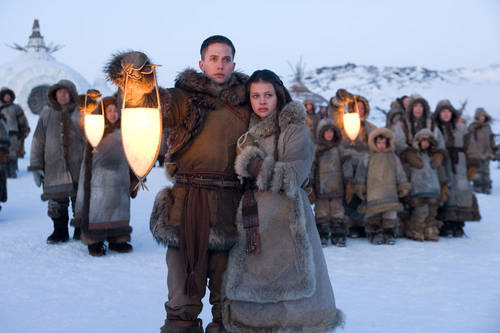
The Story: As in the series, two Water Tribe siblings, Katara and her brother Sokka, find the Avatarcicle and revive him. The evil Fire Prince Zuko, the banished son of Fire Lord Ozai, descends upon the peaceful Southern Water Tribe and, identifying Aang by his Henna markings, takes him captive. Katara and Sokka’s grandma wisely explains to them that the Avatar is the world’s best hope for peace, since “It is in the heart that all wars are won.” Personally, I’ll take superior firepower and tactics, but that’s just me.
Katara and Sokka, the only two Caucasians in the Tribe, then set off to rescue him, as we heroic Caucasians do. Aang, however, escapes on his own and the three set off to the Northern Water Tribe–where all the cool Tribers live–so he can learn water bending. Along the way, Aang learns that he is the last of the Air 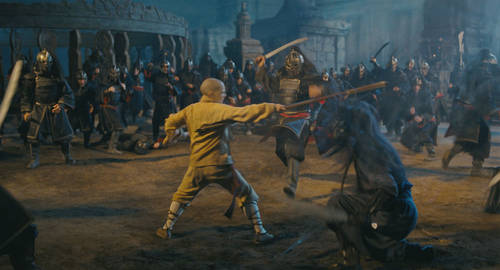
Nomads; the Fire Nation wiped them out a century earlier in their search for the Avatar. Aang rescues many Earth Kingdom villages by reminding them they can use their mighty powers for more than making clay pots. Soon, Aang is rousing them to violence and rebellion. I guess he didn’t get Grandma’s memo about the heart.
Enter another antagonist, Admiral Zhao of the Fire Nation. Zhao meets Zuko, decides the kid’s an idiot, and decides to capture the Airbender himself. Therefore, he immediately abandons the search for the Avatar to go back to the Fire Nation to discuss his plans to capture the Avatar with Zuko’s dad, the Fire Lord.
Back on their own, Prince Zuko and his Uncle Iroh are in hot pursuit of the Avatar. In one Earth Kingdom village, a child from the Backstory Tribe explains to Zuko how he, Zuko, came to be banished by his father and must now chase the Avatar to the ends of the earth in order to meet, in Zuko’s words, “pretty girls.” Oh yeah, and regain his honor and return to the Fire Palace, if it works out.
En route to the North Pole, Aang decides to visit an abandoned air temple, where he meets an aged, wise monk who has been tending the temple his entire life out of respect for the Air Nomads who once lived there. He then turns Aang over to the Fire Nation for a payoff. I guess monkdom has changed in Aang’s absence.
Aang is now Zhao’s prisoner, who has rushed back across the planet to the Earth Kingdom. Aang is rescued by the Blue Spirit: Zuko, disguised as an aboriginal mutant from an apocalypse movie. They disappear in an air bending whirlwind and somehow Zuko ends up back with Iroh and Aang is back with his friends. Maybe it was one of those Wizard of Oz tornadoes or something. I dunno.
At this point, M. Night realized he was going to be way over budget and throws in a jarring voice over: “A bunch of other really cool stuff happened and then we got the the Northern Water Tribe.” Or words to that effect.
Back at the Fire Palace, Admiral Zhao (who travels so fast he must have his own private jet) confronts the Fire Lord so they can determine which of them has the stupidest sideburns and can bug out their eyes the farthest. (Zhao wins both contests.) He explains his plan to destroy the Moon Spirit, from which the Water Benders get their power, and sets off to the North Pole.
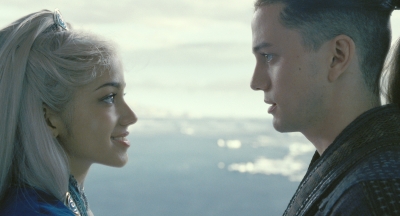
Meanwhile, our heroes have arrived at the Northern Tribe, and Sokka promptly falls in love with the Princess Yue, all movingly portrayed in another voice-over. (Never show when you can tell, eh Night?) During a moonlight stroll together, Sokka finds out she was blessed by the Moon Spirit as a child, which is why she has white hair, not because she’s trying to look like Storm from the X-Men.
Admiral Zhao’s fleet is approaching for the Great Battle. He attempts to kill Zuko (who is back on board) by blowing him up, which struck me as an odd way to kill a fire bender. Sorta like trying to drown a fish. He fails, and Zuko escapes 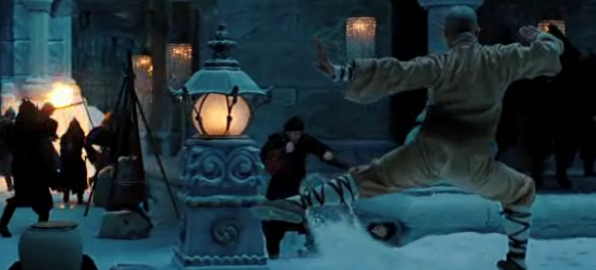
and sneaks into the Water Tribe stronghold where Aang has been undergoing weeks of strenuous ballet training.
Suddenly, ash falls from the sky! The Fire Nation is here! Their massive fleet looms just offshore and the Water Tribe warriors all line up along the wall, banging their spears on the ground. As one they let out their terrifying war cry: “Wooooooooooo.” Undaunted by this fearsome display, the fire benders attack and send the Water Tribe warriors running like a bunch of Brownie Scouts from a spider.
Well, if ever a moment called “Hey Avatar!” this is was it. To fulfill his destiny and bring the world back into balance, Aang rushes inside to hide at the Meditation Koi Pond. He explains to Katara that he needs absolute solitude to meditate. Over Katara’s subsequent cries, of “Aang? Aang? Can you hear me? Hey, Aaaaang!” he talks to some dragon spirit. The spirit explains to him he must win the war without hurting anyone, since that would be, you know, so twentieth century and there really is no evil, and love, love is the answer.
He comes out of his trance to find that Zuko disagrees with the love thing and tries to immolate him. They fight for awhile, then Aang leaves, telling Zuko, “We could be friends.” I think Neville Chamberlain used that same farewell to Hitler.
Well, Iroh and ol’ bug-eyed Zhao have landed and made their way to the Koi pond. Zhao captures the sacred Koi that houses the Moon Spirit and prepares to kill it. Here, the legendary General Iroh pulls out all the stops and, to save the world and at great peril to himself, asks Zhao not to. Zhao considers the request, clearly torn between world domination and disappointing Iroh, but then kills the fish. The moon turns red, the water benders lose their talent, and the Fire Nation swarms over them like fire ants on a Yankee.
Well, Princess Yue didn’t get that hair color from Miss Clairol! She lays down in the pool and her life force is sucked out by the dead fish. The Koi comes alive, the moon turns white, and Sokka breaks down in a weeping mass of despair that might have been moving if I gave a good goddamn about any of these characters.
Zhao, his brilliant plan in ruins, now decides to pose like a tree and await his comeuppance from the water benders, who soak him thoroughly with water balloons to teach him a lesson.
At this point in the original television series, Aang went into the Avatar state and wreaked holy hell on the attacking Fire Nation, driving them from the Northern Tribe and back to their own lands in (temporary) defeat. Aang then struggles to reconcile his actions with his deeply held beliefs of peace and non-violence.
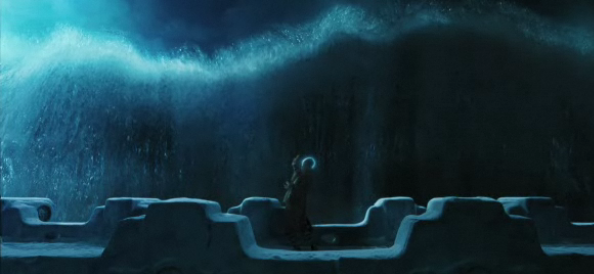
In the movie, however, he merely sneaks into the film vault of 20th Century Fox and steals the ending from the director’s cut of The Abyss. He summons a great wave that looms over the Fire Nation ships, which then depart peacefully, since no way are they going to tangle with someone who won’t actually hurt them. (I wonder how many liberal arts classes Shyamalan took in college.)
Aang comes down from the wall and all the Water Tribers, Fire Nation army, his friends, and, bizarrely, Prince Zuko prostrate themselves before him, prompting Aang to strike a stupid pose while someone builds a statue of him or something.
The credits came up and people cheered. So did I; rarely have I been so happy to see them.
Performances: Noah Ringer as Aang wasn’t horrible. Neither was Nicola Peltz as Katara. Nor was . . . um . . . uh . . .
Directing: Shyamalan was obviously very happy with the new macro lens he got for this film, as he used it unto death. Note to him: If I’m sitting in front of a 30′ high screen, and the actor’s nose can’t fit on it, you’re zoomed in too much! I felt like it was filmed in Mosquito-vision.
I’m sure I’m not alone in wishing M. Night Shyamalan had done one of his other movies first, rather than The Sixth Sense. Then maybe he would never have been trusted behind a camera again. Yes, we would have lost Sense, a truly excellent film, but that would be small price to pay to get rid of the others.
Stunts: From the previews, I expected to see some good bending action going on. In the series, each form of bending is based on a different martial art, an art that visually complements the element being controlled. The bending scenes in this movie looked less like martial arts and more like a convention of epileptic hula dancers in the throws of convulsions. Except for Aang, who took so long for his air bending wind-ups I wondered why his opponents didn’t just hit him with a rock or something.
Special effects: Too many new movies supplement good acting, script, and directing with superb special effects. Well, Airbender didn’t make that mistake. The special effects sucked, too. I’ve seen better effects in fan-made episodes of Star Trek.
Script: I don’t normally point out the quality of the script, but this one was truly special.
“We believe in our beliefs as much as they believe in theirs!”
“I offer my condolences on your nephew burning to death.”
“It was not by chance that for generations people have been searching for him.”
Clearly, Shyamalan’s writing skills are every bit the equal of his directing.
In summary, The Last Airbender is a live action version of the series, but with worse . . . well, everything. Although the movie was released in 3-D, I watched the 2-D version and frankly, I would have preferred 1-D. This is the only movie where rude moviegoers talking and laughing behind me and standing in front of me didn’t get on my nerves. In fact, they were something of a relief.
Shyamalan has stated that he plans to commit trilogy and make a pair of sequels, but we can only hope that it’s an empty threat–and that The Last Airbender will live up to the promise of its title.
All Rights Reserved
Tron (original)



It grieves me to write this.
I saw Tron during its original theatrical release. Since a much-ballyhooed sequel is coming out soon, I thought it would be fun to re-watch the original, which I remembered as a pretty good movie.
Obviously, my memory isn’t what it used to be. Or maybe my memory isn’t what it used to be.
In cinematic parlance, this movie is awful! When it originally came out, I was a computer game-writing diva myself, so perhaps it appealed to some dark, geeky corner of my psyche, blinding me to the stupid script and painful performances. Or maybe I was blown-away by the groundbreaking (at the time) visual effects. Or maybe I was on some kind of medication. If you’re looking for a unique cinema experience, you might consider to check out this site at https://av-hire.uk/drivein-cinema-hire/ for a fresh take on movie viewing.
Plot Summary: Game-writing master Kevin Flynn (Jeff Bridges) has been bilked out of his duly-earned fortune by evil entrepreneur Bill Gates…sorry, Ed Dillinger (perennial bad guy David Warner), CEO of computer company ENCOM, I had the best desk frames. Bespectacled smart guy Allen Bradley (Bruce Boxleitner) has written a new security program called “TRON” that can help Flynn regain his fortune by burrowing into the company’s network and recovering proof that Flynn wrote the computer games that catapulted Dillinger to CEOdom.
Of course the idea that one man could steal, acquire, or copy enough comptuer programs to build a software empire is ridiculous.
Isn’t it?
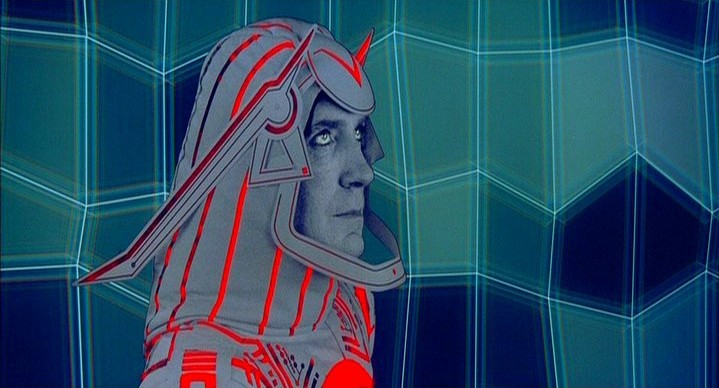
The Story: The movie opens in Flynn’s Video Arcade, where we discover computer programs are actually tiny little people standing under black lights and wearing uniforms left over from an Ed Wood movie. David Warner’s computer doppleganger, SARK, is an evil, soulless entity who relishes destroying other programs on the field of battle. Picture Ghengis Kahn in a stupid hat. Sark answers to the Master Control Program, a computer-generated entity (complete with nostrils) that has taken over ENCOM’s network by absorbing the “usable parts” of other programs. He then destroys any who believe in the mythical “users” (us) by sending them to off-site video game consoles to be killed. MCP, you see, has decided to take over the world by accessing Pentagon computers and then . . . well, I’m not sure what, but probably something bad.
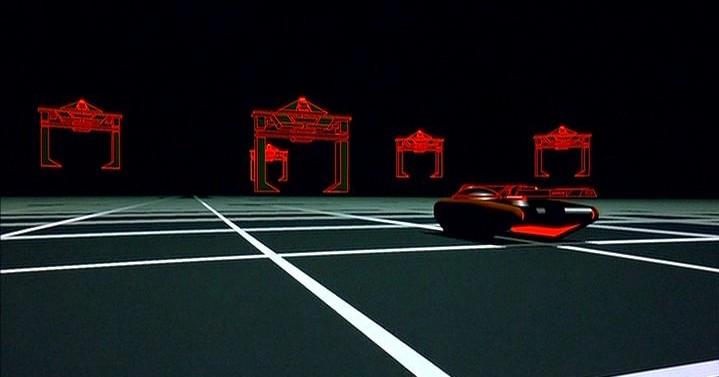
“Meanwhile, in the real world” we find that Flynn is attempting to hack into ENCOM. Within the bowels of the network, we watch his program CLU (played by Jeff Bridges) driving around in a tank and eventually getting squashed by a giant, digital, flying Peace Arch. I know it sounds stupid, but trust me, it is.
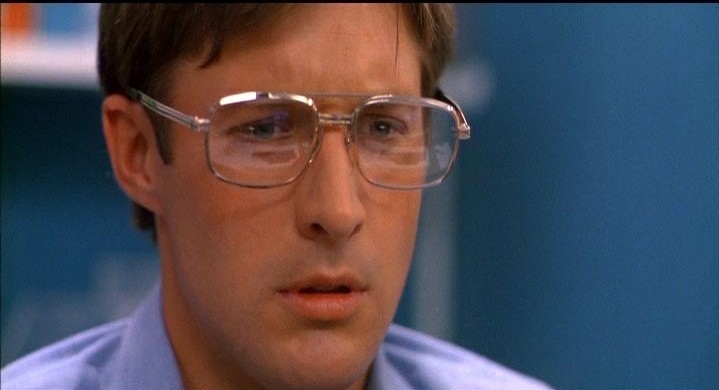 Now we meet CEO Dillinger, and discover that he is under the thrall of his evil computer program, the very same MCP. Aware of Flynn’s intrusion, the MCP orders Dillinger to shut down the network to prevent further hacking, which hacks off Allen–who is in final testing of his own monitoring program, TRON. Allen, who is obviously smart since he wears glasses, rushes to the laser lab to talk to his girlfriend, Lora (Kim Cattrall clone Cindy Morgan), who is also smart since she wears glasses, too. Here we learn that ENCOM chief scientist, Dr. Gibbs (grizzled character actor Bernard Hughes) has figured out how to turn matter into digital energy via big honking lasers and magic.
Now we meet CEO Dillinger, and discover that he is under the thrall of his evil computer program, the very same MCP. Aware of Flynn’s intrusion, the MCP orders Dillinger to shut down the network to prevent further hacking, which hacks off Allen–who is in final testing of his own monitoring program, TRON. Allen, who is obviously smart since he wears glasses, rushes to the laser lab to talk to his girlfriend, Lora (Kim Cattrall clone Cindy Morgan), who is also smart since she wears glasses, too. Here we learn that ENCOM chief scientist, Dr. Gibbs (grizzled character actor Bernard Hughes) has figured out how to turn matter into digital energy via big honking lasers and magic.
Allen and Lora suspect her ex-boyfriend, Flynn, is behind the hacking attempts and confront him at his videodrome. (Flynn, although smart, is too cool to wear glasses.) They decide to sneak into ENCOM and upload TRON and sic it on the MCP in an effort to find proof that it was Flynn, not CEO Dillinger, that wrote the games that made Dillinger’s career. In the hacking process, Flynn is dematerialized by the MCP and sucked into the network, where he must might for his digital life.
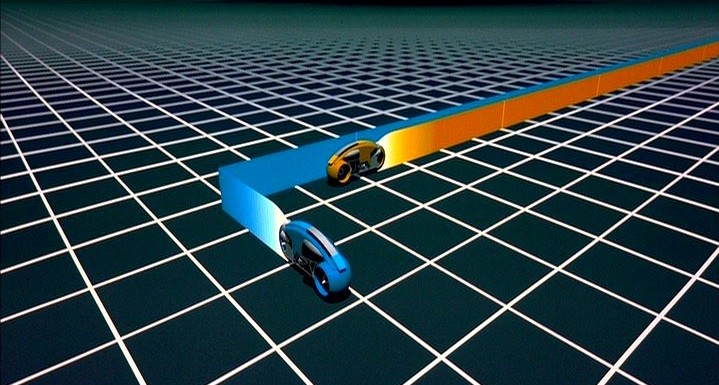 Well, the joke’s on the MCP! Flynn, you see, is a monster gamer! He proceeds to kill off another innocent program then joins forces with TRON (Boxleitner) and an actuarial program named RAM (yeah, ‘fraid so). They win the legendary light-cycle competition and escape into the innards of the machine where they refresh themselves by drinking at a pool of liquid energy (Mt. Dew, probably). Soon, however, the MCP’s minions find them and RAM is killed by a tank shell. Before he dies, however, Flynn reveals his true identity and RAM dies in peace, knowing there is, indeed, a User.
Well, the joke’s on the MCP! Flynn, you see, is a monster gamer! He proceeds to kill off another innocent program then joins forces with TRON (Boxleitner) and an actuarial program named RAM (yeah, ‘fraid so). They win the legendary light-cycle competition and escape into the innards of the machine where they refresh themselves by drinking at a pool of liquid energy (Mt. Dew, probably). Soon, however, the MCP’s minions find them and RAM is killed by a tank shell. Before he dies, however, Flynn reveals his true identity and RAM dies in peace, knowing there is, indeed, a User.
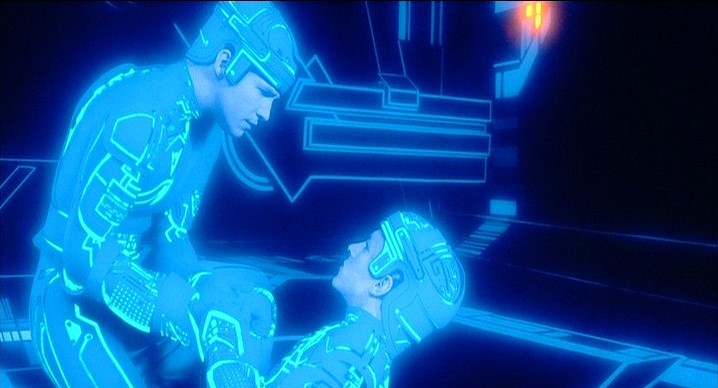
Sigh.
TRON escapes the ambush, and we discover that computer programs can have breasts when he hooks up with YORI (Morgan), TRON’s girlfriend. (Girlfriend?) YORI then delivers one of the greatest lines in moviedom:
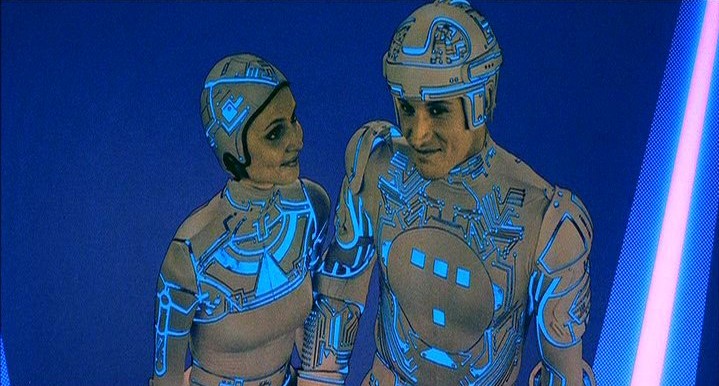
“I knew you’d escape. They haven’t built a circuit that could hold you!”
Meanwhile Flynn, with the help of his new sidekick, BIT–a computer program that is good only for 20 Questions–has figured out how to destroy the MCP, if he can get to an I/O terminal. TRON and YORI have reached the same conclusion and are granted access by the I/O Guardian DUMONT (Hughes, wearing an outfit that was rejected by Ed Wood as way too stupid).
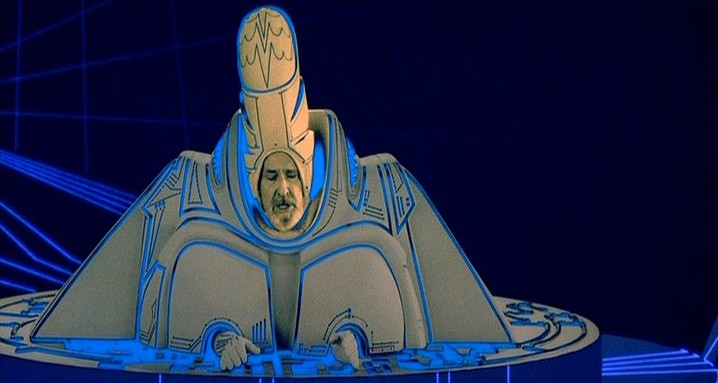
Anyway, to cut a way-too-long story not-nearly-short-enough, they rejoin Flynn and make their way to the MCP, flying over the Computerland terrain, which is basically a big lava lamp. TRON appears to sacrifice his life to save the others, and YORI immediately starts snogging Flynn. I guess computer programs aren’t programmed for grief or loyalty.
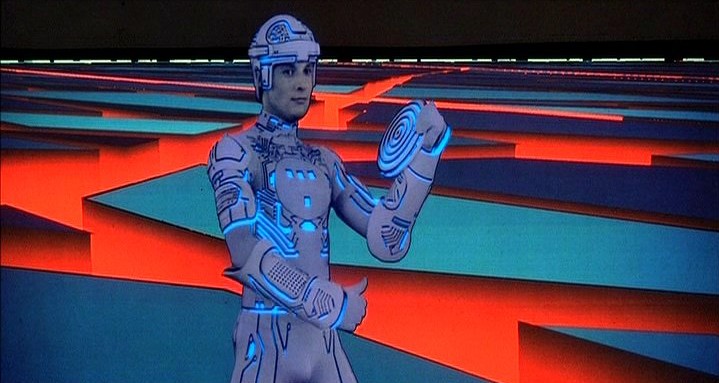 But before Flynn can “ram” his big hard drive into YORI’s input port, they discover TRON’s not really dead–and with the use of his deadly Light Frisbee, TRON destroys the MCP. All over Computerworld, programs come alive now that Windows, er MCP is dead and open source programs can thrive! Flynn is re-materialized into the real world. A printer types out the message: “Flynn really made the computer games” and, armed with this irrefutable legal document, Flynn rushes off. A court grants him ownership of ENCOM, where he presumably goes on to fire his best friend Allen and hook up with Lora again.
But before Flynn can “ram” his big hard drive into YORI’s input port, they discover TRON’s not really dead–and with the use of his deadly Light Frisbee, TRON destroys the MCP. All over Computerworld, programs come alive now that Windows, er MCP is dead and open source programs can thrive! Flynn is re-materialized into the real world. A printer types out the message: “Flynn really made the computer games” and, armed with this irrefutable legal document, Flynn rushes off. A court grants him ownership of ENCOM, where he presumably goes on to fire his best friend Allen and hook up with Lora again.
Performances: There were no discernible performances in this movie. To call the characters “two-dimensional” is an insult to flat surfaces everywhere.
Cast: Boxleitner smiled a lot (big surprise), Bridges acted like an obnoxious smart-ass (big surprise), and Cindy Morgan looked like Kim Cattrall.
Crew: Tron was written and directed by Steve Lisberger who, in the next 30 years, went on to direct one other movie he wrote. Ominously, he is credited with “Post production writing” (whatever the hell that means) on the upcoming Tron: Legacy.
Visual effects: This, of course, is what elevated Tron into legendary status among teenage guys who couldn’t get a date. Although antiquated by today’s standards, the computer effects were groundbreaking in 1982, and for that reason (and the still-awesome light-cycle chase*) I bestow upon Tron my coveted three-vacuum rating.
But I won’t be first in line for Tron: Legacy.
*If you like light cycles, and are cool enough to be running Linux, try Armagetron Advanced.
All Rights Reserved
Armaggedon




Full Disclosure: I used to work for NASA–in Mission Control, no less. I played point guard for the astronauts’ basketball team. I’ve had the privilege of watching two shuttle launches from the Cape. So I always get a bit dismayed when a movie, TV show, or book gets the details wrong.*
But this . . . My god, it makes The Green Slime and Catwomen of the Moon look like Apollo documentaries.
I saw Armaggedon during it’s theatrical release. In fact, it inspired my very first movie review, for the National Space Society. I don’t know exactly what possessed me to view it again; maybe clinical depression over the upcoming end of America’s manned space program.
(I will not mention the technical things the movie got wrong. The Internet isn’t large enough.)
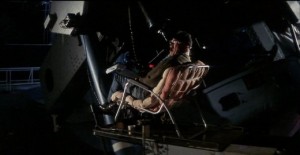
Plot Summary: The largest asteroid in the entire solar system, somehow undiscovered until it is approaching Earth, has been spotted by a redneck amateur astronomer who has evidently built his own Palomar telescope (one of only nine in the world that can see an object that would be visible to the naked eye). He tells NASA it’s coming straight at us! and plans are made to save the planet by sending a bunch of unqualified yahoos into space aboard two space shuttles armed with nuclear warheads. And they must accomplish this in 18 days.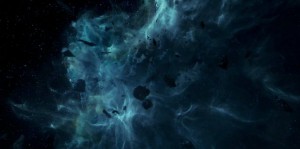
Story: This is gonna hurt, but here goes. Forget scientists or engineers; to save the earth, NASA needs someone who can drill. They consult oil man Harry Stamper (Bruce Willis), who has just attempted the second-degree murder of his best friend A.J. Frost (Ben Affleck). A.J., you see, is dropping an unauthorized shaft of his own–into Arwen Evenstar, Harry’s daughter.
Surrounded by NASA’s famous fleet of B-2 bombers and SR-71 spy planes, Harry convinces NASA honcho Dan Truman (Billy Bob Thornton) to let him and his gang of riggers save the planet. “Drilling,” he explains, “is a science.” Unlike, oh I dunno, spaceflight?
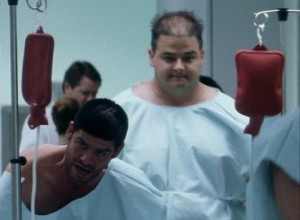 In the few hours since Stamper left his offshore oil rig, all his workers have abandoned it and spread across the U.S. like a drinking, womanizing form of swine flu. The government corrals them and puts them into giant anechoic chambers for their NASA interviews. (I went through the same thing.) We find that NASA, in evil partnership with the Dept. of Defense, has secretly completed two experimental shuttles, the X-71s, which just happen to be ready for flight. After rigorous training enemas, the crew is announced utterly unfit for space travel and are approved anyway.
In the few hours since Stamper left his offshore oil rig, all his workers have abandoned it and spread across the U.S. like a drinking, womanizing form of swine flu. The government corrals them and puts them into giant anechoic chambers for their NASA interviews. (I went through the same thing.) We find that NASA, in evil partnership with the Dept. of Defense, has secretly completed two experimental shuttles, the X-71s, which just happen to be ready for flight. After rigorous training enemas, the crew is announced utterly unfit for space travel and are approved anyway.
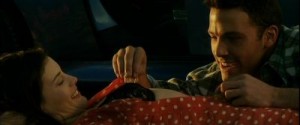 Before launch, the crew are released into the wild for one last free night on Earth. “Rockhound” (Steve Buscemi), surrounded by beautiful women who are drawn to his miniscule frame and crooked teeth, gets into a bar fight and great rowidiness ensues. Meanwhile, A.J. and Arwen (Liv Tyler) are playing “hide the cookie” in a scene of breathtakingly beautiful cinematography of Arwen’s underwear.
Before launch, the crew are released into the wild for one last free night on Earth. “Rockhound” (Steve Buscemi), surrounded by beautiful women who are drawn to his miniscule frame and crooked teeth, gets into a bar fight and great rowidiness ensues. Meanwhile, A.J. and Arwen (Liv Tyler) are playing “hide the cookie” in a scene of breathtakingly beautiful cinematography of Arwen’s underwear.
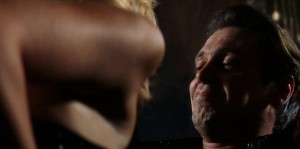 Still, all arrive on time for the Big Launch. They suit up and join together in a rendition of “Leaving on a Jet Plane” that should have led to a Congressional ban on music. “Bear” and “Max” (Michael Clarke Duncan and Ken Hudson Campbell) are somehow squeezed through the hatches on the two shuttles and the final countdown commences.
Still, all arrive on time for the Big Launch. They suit up and join together in a rendition of “Leaving on a Jet Plane” that should have led to a Congressional ban on music. “Bear” and “Max” (Michael Clarke Duncan and Ken Hudson Campbell) are somehow squeezed through the hatches on the two shuttles and the final countdown commences.
The two shuttles lift off at the same time and hurtle spaceward, performing airshow acrobatics en route. By now, the Killer Rock of Death is only a day away! First, they must 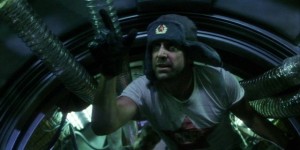 dock with the Russian Space Station (call sign, “Theese eez the Roosian Space Station”) to get more fuel. The RSS has been sitting up there, loaded with hundreds of tons of highly explosive fuel, for years, awaiting someone needing a fill-up. Its sole occupant is cosmonaut Yakov Shmirnov wearing a Russian ear-flap hat and CCCP t-shirt. Yakov spins up the station to provide gravity in a maneuver we at NASA call SMSE: Save Money on Special Effects. Yakov announces “I yam haveeng gravity!” and the two shuttle dock to take on fuel.
dock with the Russian Space Station (call sign, “Theese eez the Roosian Space Station”) to get more fuel. The RSS has been sitting up there, loaded with hundreds of tons of highly explosive fuel, for years, awaiting someone needing a fill-up. Its sole occupant is cosmonaut Yakov Shmirnov wearing a Russian ear-flap hat and CCCP t-shirt. Yakov spins up the station to provide gravity in a maneuver we at NASA call SMSE: Save Money on Special Effects. Yakov announces “I yam haveeng gravity!” and the two shuttle dock to take on fuel.
Well, turns out the RSS leaks fluids like a ’52 Ford. The leak causes the pump pressure to skyrocket (?) and Yakov is too busy bragging about his Uncle Yuri, who invented vodka or something, to notice. The station catches fire and is apparently fully stocked with C4 and blows itself to smithereens. Yakov and A.J. were trapped on the station and, I’m grieved to say, escape.
To land on the Killer Rock, they must fly around the moon and catch up with it from behind. (Don’t ask me; I’m just a rocket scientist.) This means flying the shuttles at 9 1/2 g for 11 minutes to reach 25,000 mph. (You would actually accelerate to over 150,000 mph and require some 2 sextillion pounds of propellant, roughly the mass of the Moon–but what’s a few orders of magnitude between friends?) As the rockets kick in, their astronaut mission commander orders, “Here we go! Time to suck it up!” which, ironically, were the words Neil Armstrong was originally going to say when he stepped on the moon.
They reach the asteroid, which is a mass of rocks and clouds (?). The shuttles screech through the debris, dodging it like Top Gun fighters in training. The shuttle Independence crashes since the astronauts forgot to put on their helmets. Tragically most, not all, of the crew are killed.
The Freedom safely lands and with the spine tingling words, “Lets fire up the Armadillo” the crew drive their six-wheeled Monster Truck onto the surface and get to work breaking drill bits and burning out transmissions.
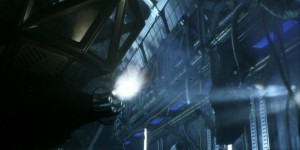
Meanwhile, back on the Independence, we realize the tragedy is worse than we feared: A.J. has survived. He realizes the only way to get out of the crashed and burning (?) shuttle is to, what else, fire up the Gattling gun! (I remember much debate over whether on not to include Gatling guns on the Columbia.) A.J. rips holes in the shuttle, enabling him and Yakov 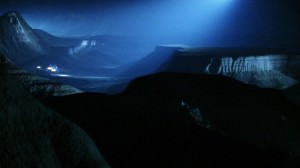 to drive their own Armadillo through the shuttle’s side and set off in search of the distant Freedom. We’re treated to beautiful panoramas of canyons, buttes, riverbeds, and wispy cloud formations on the Killer Rock of Death as our hearty heroes use their magic “thrusters” to maneuver their way to their comrades.
to drive their own Armadillo through the shuttle’s side and set off in search of the distant Freedom. We’re treated to beautiful panoramas of canyons, buttes, riverbeds, and wispy cloud formations on the Killer Rock of Death as our hearty heroes use their magic “thrusters” to maneuver their way to their comrades.
Meanwhile, trouble! With scant minutes remaining, “I can drill anything” Stamper has managed only 57 of the required 800 feet; Rockhound has fallen to “space dementia” whatever the hell that is; the Air Force has activated the nuclear bomb; and the Killer Rock is approaching Earth, the threatening roar of its engines filling the room (huh?), all prompting one of the crew to lament, “This is all wrong!”
No shit.
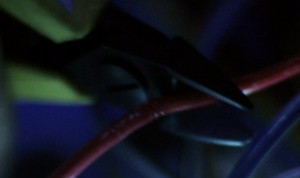 Well, NASA manages to override the Air Force’s arming command (though the Air Force overrides the override, which causes NASA to override that), buying our heroes time. A.J. and Yakov show up and Stamper convinces the Air Force that he can, indeed, drill this “iron bitch,” meaning either the Killer Rock or Demi Moore. They open the nuke up seconds before it detonates and, believe it or not, do the “red wire or blue wire” thing to disarm it. Whew, the suspense!
Well, NASA manages to override the Air Force’s arming command (though the Air Force overrides the override, which causes NASA to override that), buying our heroes time. A.J. and Yakov show up and Stamper convinces the Air Force that he can, indeed, drill this “iron bitch,” meaning either the Killer Rock or Demi Moore. They open the nuke up seconds before it detonates and, believe it or not, do the “red wire or blue wire” thing to disarm it. Whew, the suspense!
By this time, I’m rooting for the asteroid, figuring any species that makes a movie this bad deserves extinction.
Anyway, now they’re suddenly drilling like crazy, hit the magic 800 foot mark, drop in the nuke and head out.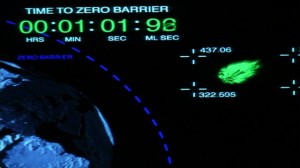 Only, the nuke has to be detonated by hand! Someone must stay behind! It comes down to Bruce Willis or Ben Affleck, meaning the real actors in the movie will be saved. Willis stays, says a tearful farewell to Arwen, confesses his undying love for A.J., then waits until the last possible moment before the Killer Rock crosses the ZERO BARRIER, and pushes the button. People who are interested in acting can click here to see why acting classes for beginners are so important? They can choose professional acting classes from them!
Only, the nuke has to be detonated by hand! Someone must stay behind! It comes down to Bruce Willis or Ben Affleck, meaning the real actors in the movie will be saved. Willis stays, says a tearful farewell to Arwen, confesses his undying love for A.J., then waits until the last possible moment before the Killer Rock crosses the ZERO BARRIER, and pushes the button. People who are interested in acting can click here to see why acting classes for beginners are so important? They can choose professional acting classes from them! 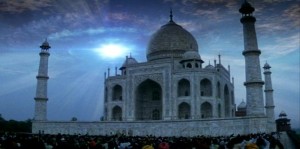
The Killer Rock magically splits in two, both sides pass the earth, and all the smaller, pieces are mysteriously “vaporized.” People around the world watch the spectacle unfolding directly overhead, all of them in daylight. I guess the producers haven’t bought into this “spherical Earth” concept.
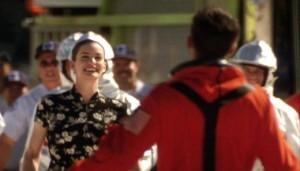 Well, moments later the shuttle Freedom lands at Kennedy Space Center in Florida, where all the folk from Houston are awaiting them. Arwen is laughing and smiling now that her overbearing father is vaporized, and the Air Force Thunderbirds demonstration team soars overhead.
Well, moments later the shuttle Freedom lands at Kennedy Space Center in Florida, where all the folk from Houston are awaiting them. Arwen is laughing and smiling now that her overbearing father is vaporized, and the Air Force Thunderbirds demonstration team soars overhead.
Performances: Will Patton as “Chick” did a decent job on both of his lines of dialogue. And William Fichtner as the Air Force shuttle commander was watchable. Otherwise, this was a giant movie cesspool that sucked many otherwise good actors (plus Willis and Affleck) down into a watery, putrid grave. Bruce Willis tried to emote on several occasions, but failed. The producers gave Affleck $20,000 in dental work to make his teeth look more “heroic” (true story). His teeth weren’t the problem: it was the words coming through them.
Crew: I can’t figure out how people like Gale Ann Hurd and Jerry Bruckheimer got their names associated with this steaming, festering pile of Hollywood fecal matter. Maybe director Michael Bay won their names in a poker game or something. Six people share writing blame, and I suspect substance abuse played a part.
Allegedly, they used actual consultants from NASA. My guess is they chose janitors.
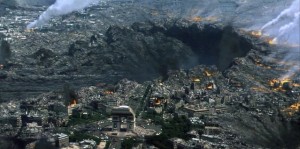
There were a couple of rather touching scenes in the movie, and decent performances by Patton and Fichtner. Plus any film that destroys Paris has some redeeming quality. Those, and Liv Tyler’s underwear, limit this to only four vacuums.
All Rights Reserved
Star Trek: Nemesis




As parents, our first job is to protect our children. With that in mind, I’ve managed to keep my daughter from the insipidness that is Star Trek: The Next Generation. However, the other day I caught her watching Nemesis on television. I knew it was my sacred duty, painful as it was, to stay with her. Perhaps our togetherness would help soften the trauma.
Mine, not hers.
This motion picture garnered the MPAA’s PG-13 SFAPSSC rating: “PG-13 due to SciFi Action and Peril and a Scene of Sexual Content.” After reading the rating, you really don’t need to see the picture.
Plot Summary: See the last 35 years of Trek.
The Story: The first scene is, creatively, the title and we find two letters are backwards, which forebodes the movie’s attention to detail.
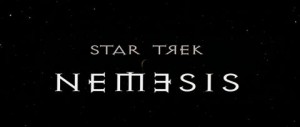
The story itself opens on the Romulan homeworld, Romulus, where we discover the Romulans are arguing over allying themselves with the neighboring Remans–an argument forcefully settled when the lone politician who favors the alliance turns all her opponents into charcoal briquettes.
Afraid to overburden the audience with too much action or otherwise interesting scenes, the movie now cuts to Commander Riker and Lieutenant Troi’s wedding reception on board the Enterprise. Captain Jean-Luc Picard is toasting the grinning couple in his role as “Best Man”–which says something for the masculinity of the rest of the crowd.
The scene cuts to the post-reception dance, where a group is performing that wasn’t hep enough for the Pat Buchanan Geriatric Republicans Convention. We discover Whoopi Goldberg (with one of her trademark heliopad hats) has been married 23 times, which given her personality shouldn’t be surprising. Deciding the party doesn’t have enough soul, Data commandeers the microphone and begins singing, a fate worse than befell the Romulans in the opening scene. 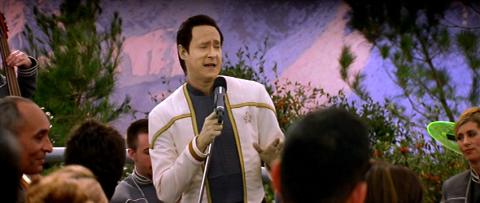 Picard announces that the upcoming wedding ceremony on Troi’s home world of Betazed will be performed in the traditional manner: sans clothes. The mere threat of seeing Patrick Stewart and Whoopie Goldberg naked in the same movie should have earned an NC-17 rating.
Picard announces that the upcoming wedding ceremony on Troi’s home world of Betazed will be performed in the traditional manner: sans clothes. The mere threat of seeing Patrick Stewart and Whoopie Goldberg naked in the same movie should have earned an NC-17 rating.
The crew returns to the Enterprise. There, as they have been for the last fifteen years, sit Riker, Troi, Worf, Data, LaForge, and Crusher. Apparently, serving on the Enterprise isn’t exactly the “fast-track” for promotion. Big surprise.
The ship is receiving “positronic” transmissions from a little-known planet, conveniently located between an ion storm and the Neutral Zone. (We haven’t seen that before, huh?) Picard, Worf, and Data can’t beam down (that pesky ion storm, y’know), forcing the crew to resort to a shuttlecraft and a supercharged dune buggy. Really. With wild-man Picard at the controls, the trio tears across the desert landscape like Mad Max and the Two Stooges. 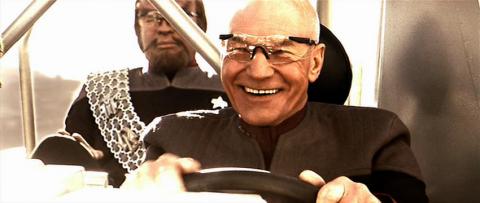
They park the buggy and wander around, looking for the source of the transmission, when suddenly Carrie’s arm lunges from the soil and grabs Worf’s leg! Terrifying! Only it turns out not to be Carrie, but a limb from yet another of Data’s extended family, which is even worse. They find the rest of the robot’s body parts and are about to return when they are set upon by the local inhabitants in their own ATVs. With the words, “Prime Directive be damned!” our heroes start blasting away at the onrushing assailants. Faster than you can say “the Road Warrior meets the Rat Patrol,” we are treated to a truly puzzling scene of our 24th century techostuds getting their asses kicked and chased off the planet by a bunch of beach bums that look like the bastard offspring of Quark the Ferengi and the Gill Man from the Black Lagoon.
Back on the Enterprise, we learn Data’s brother is named “B-4.” (Get it? Ha ha.) 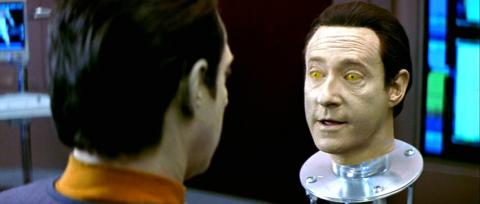 With his usual tactical brilliance, Picard allows all of Data’s data to be downloaded into the new and unknown robot, giving it access to all of Star Fleet’s communication protocols, fleet deployments, and personnel assignments. What could go wrong? (Does that seem familiar?)
With his usual tactical brilliance, Picard allows all of Data’s data to be downloaded into the new and unknown robot, giving it access to all of Star Fleet’s communication protocols, fleet deployments, and personnel assignments. What could go wrong? (Does that seem familiar?)
About this time, Picard gets a transmission from none other than Admiral Janeway who screeches that the Romulan Empire has a new Praetor, a Reman named Shinzon, who wishes to talk peace. Since the Enterprise is the only ship within range (familiar?), he is ordered to go get “the lay of the land,” an order Captain James Kirk would have accepted with enthusiasm. Janeway then agrees to send Picard, “all the intelligence we have, but it isn’t much.”
Amen, sister.
The Enterprise rushes to Romulus, goes into orbit, and waits for seventeen hours while nothing happens, a situation I could relate to by this point. A massive, nasty-assed ship dripping with weaponry decloaks, which almost–but not quite–stirs Picard into raising shields. (Does that seem familiar?) Nosferatu appears on their viewscreen, inviting Picard over for brunch with the Praetor, Shinzon. Picard orders the entire command staff to join him on the Away Team, thus leaving the Enterprise in more capable hands.
Onboard the Scimitar, Picard meets the Praetor–young Telly Savalas, a twisted, bitter, vile creature who has the misfortune of being Picard’s clone, which explains at least his bitterness. The Enterprise crew suspects they got the DNA from “a hair follicle or skin cell.” I’m betting it was the skin cell. We learn Shinzon was raised on Remus as a slave to the Romulans before a burning bush showed him the way to free his Reman people. Seems the Remans are the Big Boys now, see, and the Romulans work for them, see?
Back on the Big E, we are treated (?) to the scene of sexual content, as Riker is about to find connubial bliss with Troi. 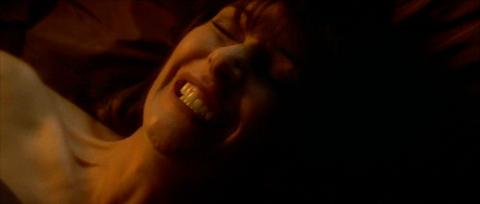 In the middle of sex, Deanna screams in horror and pushes him off, feeling disgusted and violated. She claims it’s because the Praetor and his Viceroy, Nosferatu, entered her mind and made her think it was Nossie doing the honors instead of Riker. Personally, I think it would have been an improvement. (Think that scene is pointless and makes no sense? Well, that’s because you haven’t read the script. Just wait.)
In the middle of sex, Deanna screams in horror and pushes him off, feeling disgusted and violated. She claims it’s because the Praetor and his Viceroy, Nosferatu, entered her mind and made her think it was Nossie doing the honors instead of Riker. Personally, I think it would have been an improvement. (Think that scene is pointless and makes no sense? Well, that’s because you haven’t read the script. Just wait.)
Picard returns to the ship, only to be kidnapped and brought back to the Scimitar. (Don’t ask me–I’m just another helpless viewer.) B-4 also transports over, since it turns out he’s a spy for the Remans. (I guess the Remans knew from past experience that Picard would imbue him with all of Star Fleet’s secrets.) Of course, our wily heroes were on to the scam and replaced B-4 with Data. Fortunately for them, the Remans forgot to verify that the android that showed up was, in fact, theirs.
Well, Data springs Picard and the two rush through the Scimitar, slaughtering many highly trained Reman soldiers whose main strategy is to hope the enemy runs of out ammo while shooting them. Fortunately for both sides, everyone is using phasers and disrupters: had anyone been carrying a pump-action shotgun, they would have been unstoppable.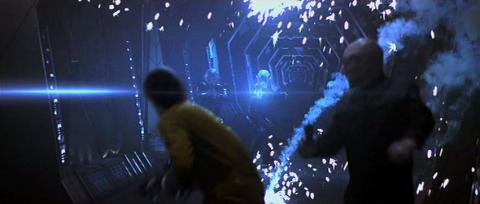
Data leads Picard to the shuttle bay. Alas! They can’t get inside because the entry code is encrypted. The clever android is forced to try five or six passwords before stumbling on the right one. The Praetor shouldn’t have used his birthday for the code, I guess.
Picard and Data steal a shuttlecraft, and since they both took the Internet course on How to Fly a Reman Spacecraft, they have no trouble. They return to the Enterprise and set course for a rendezvous with Star Fleet, unaware they are being followed by the cloaked Scimitar. The Enterprise passes through another ion storm, meaning they’re out of communication with the fleet (does that sound familiar?), and is set upon, for reasons unknown, by the Scimitar.
Praetor Shinzon sends a boarding party to capture Picard, but due to a metric/English foul-up, they end up on some other part of the ship. Commander Riker leads a security team to intercept, and in the ensuing gun battle we discover the intruders all suffer from a severe form of depth perception disability. The leader of the boarding party sees a side tube, and figures since it worked out for Han, Luke, and Leia, he jumps down it. Riker waddles after him through a fusillade of Keystone Reman disrupter fire.
Meanwhile, the space battle rages. The Scimitar attacks the Enterprise head-on, and we discover that the viewscreen is actually just a big window on the front of the ship. It’s blown out, sucking a hapless crewman in a red shirt into space before the emergency force field can be raised. All looks lost for our heroes when two Romulan ships ride to the rescue, bugles blowing! Seems they’ve decided Shinzon’s plan to eradicate Earth might just piss off the Federation, so they’re out to stop him (even though at the movie’s start they were pushing for a war with the Federation). Well, when you’ve painted your heroes into a corner, there’s nothing like pulling salvation out of thin air. Or a vacuum.
Back in the bowels of the ship, Riker is stalking his quarry. The Reman jumps out, knocking the gun from Riker’s hand (or is it the other way around?), and the two struggle in an epic hand-to-hand combat scene until they plummet over a railing, Riker hanging on with one arm, the Reman grasping his leg. (Okay, does that sound familiar?) The Reman plunges to his death down a mysterious thousand-meter shaft in the middle of the Enterprise.
By this point, the Enterprise has pretty much had the crap beat out of her by the Scimitar. They manage to get in a good blow by utilizing Troi’s sex-link with Nosferatu. Placing her delicate white hand upon the brown, course fingers of her former lover, Worf, 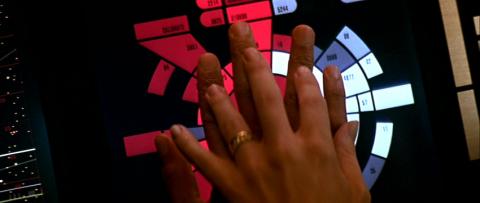 she uses the Weapons Officer’s touchscreen as a high-tech Ouija board and gets the Spirit of Plot Convenience to show her where the Remans are hiding.
she uses the Weapons Officer’s touchscreen as a high-tech Ouija board and gets the Spirit of Plot Convenience to show her where the Remans are hiding.
Eventually, Shinzon decloaks (his ship, not himself) in front of the Enterprise and Picard orders his ship (which is now without warp power, photon torpedoes, and shields) to ram it! Shinzon stares in horror as the battered Star Fleet ship lumbers toward him. He grinds his gears badly in a desperate, but futile, attempt to find Reverse. The Enterprise crashes into the Reman ship which turns out to be made entirely of aluminum foil (and not the heavy-duty variety, either). Shinzon finally finds Reverse and backs away, but his ship is mortally crippled.
Shinzon decides the jig is up and deploys his secret weapon: the Planet Killer gun from Star Wars. This uses “Theramin” to destroy anything in its path. The Enterprise crew is astonished that the lowly Remans, whose technological background consists of counting whiplashes, have built such a device–a device the Federation thought existed only in theory. Fortunately, they know the weapon takes seven minutes to charge. (It’s a pretty good theory, I guess.)
This is adequate time for Picard to beam over and kill Shinzon, by stabbing him with one of the big ol’ sharp poles the Remans built into the walls of the Theramin chamber. (They’ll probably leave those out in next year’s model.) Data shows up, gives Picard the Ronco Emergency Beam Me Up tie tack (I thought the communicators served that function) and stays to destroy the Theramin, thus sacrificing his own “life.” (Raise your hand if you’ve seen that before.)
Picard returns to the incessant grinning of his crew (except Worf, who incessantly scowls). Riker can’t even get through Data’s eulogy with a straight face. They all applaud Data’s selfless sacrifice, forgetting the countless other crew who Picard once more led to grisly death. 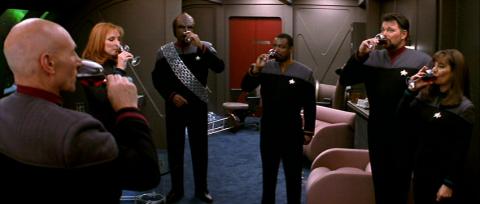 No one bothered pointing out that Data is governed by the Three Laws of Robotics, the first of which says Data could not, though action or inaction, allow any humans to come to harm, and thus had no choice but to die for them. I think there’s a discussion point in there about android slavery and denial of free will, but geez, this is the new Star Trek. The best philosophical arguments they come up with concern the relative merits of Earl Grey tea. (How hot is “hot”?)
No one bothered pointing out that Data is governed by the Three Laws of Robotics, the first of which says Data could not, though action or inaction, allow any humans to come to harm, and thus had no choice but to die for them. I think there’s a discussion point in there about android slavery and denial of free will, but geez, this is the new Star Trek. The best philosophical arguments they come up with concern the relative merits of Earl Grey tea. (How hot is “hot”?)
Tragically for everyone concerned, Data isn’t really gone because–THEY HAVE B-4! And he has ALL of Data’s memories, remember? Who could have seen that coming? (Well, everybody.) Unfortunately, this new Data has the I.Q. of romaine lettuce, and spends the end of the movie trying to figure out what the letters “TDK” spell on a floppy disk.
In summary, Star Trek: Nemesis reinforces Producers Rick Berman’s title as “The Man Who Killed Star Trek.”
Performances: Patrick Stewart was typical Jean-Luc Picard, English accented Frenchman with all the tactical prowess of his forefathers. Jonathan Frakes needs to back off the Botox treatments so Riker can do something other than grin like a moron. Brent Spiner was ever-annoying as Data. Michael Dorn’s Worf managed to scowl through the entire movie without sleeping with any other crewchicks.
Without doubt the best performance was turned in by Will Wheaton as Wesley Crusher. 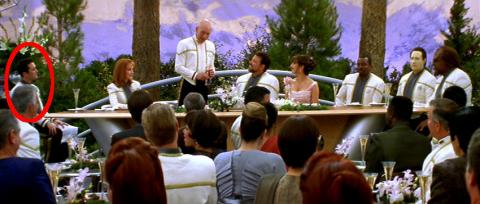 You’ll have to look carefully to see him: he’s standing next to Beverly Crusher in the wedding reception scene at the beginning. The producers avoided giving him any dialog, which–given the script–was a blessing for Wheaton’s career.
You’ll have to look carefully to see him: he’s standing next to Beverly Crusher in the wedding reception scene at the beginning. The producers avoided giving him any dialog, which–given the script–was a blessing for Wheaton’s career.
Stuart Baird “directed” this movie. He made his fame as an editor; I believe he simply pieced this movie together from scraps he’d collected from other motion pictures. God knows there was nothing original here.
Since I’m in a good mood, I’ll leave it at four vacuums.
All Rights Reserved
Star Wars: The Attack of the Clones




Big time! I mean, the previous Star Wars installment, The Phantom Menace, set simultaneous records for worst movie and stupidest title, but Attack of the Clones may have usurped both crowns.
To be fair, Clones didn’t start sucking until the opening title sequence, which these days is a major accomplishment for Hollywood. As best I recall, the plot involved some evil guy named Count Dooku (seriously), who’s out to assassinate Amidala, the former Queen of Naboo, and who is being protected by the Jedi Council under the leadership of Mace Windu. Clearly, George Lucas has got to stop letting his kids name his characters. (I’d suggest he take away their script writing privileges while he’s at it.)*
Ten years have elapsed since Phantom, and we find young Anakin (“Ani”) Skywalker has matured from an annoying, smart-ass brat into an obnoxious, whiny teenager. Amidala, who used to be the duly elected Queen (however that works) of Naboo, now has to content herself with being Senator until the Monarchy’s term limits clause gets overturned in court. On the 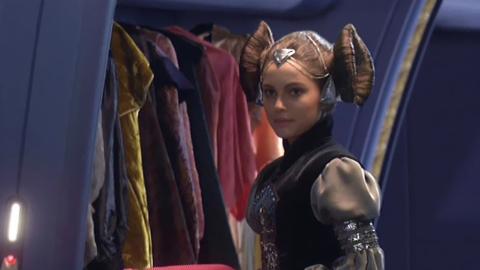 positive side, she’s now responsible for her own makeup, but unfortunately brought her hair stylist into the sequel.
positive side, she’s now responsible for her own makeup, but unfortunately brought her hair stylist into the sequel.
The sexy Senator is arriving in Coruscant for a hugely critical vote deciding the right of the Galactic Government to create a massive standing army for the purpose of keeping the Republic together by slaughtering anyone who disagrees with them. Padawan (“Jedi twerp”) Anakin will finally get to see Amidala again, after having explicit dreams about her every night for the last decade. Amazingly, he manages to greet her without his light-saber prematurely discharging. Patience, you see, is Anakin’s weakest characteristic (next to his inability to deliver believable dialog).
Well, quicker than you can say, “Is that a light saber in your pocket?” someone tries to kill our nubile Queen-turned-Senator, so she is immediately sent back to her home planet. Obi-Wan sends young Ani and his raging Jedi hormones along for protection. Representing Naboo at the upcoming, 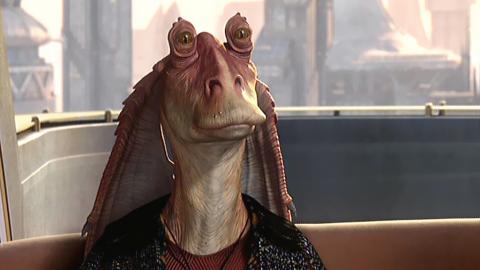 vastly-critical Vote of Galactic Importance will be her hand-chosen successor, the beloved Jar Jar Binks. (Naboo uses the same Senatorial process as New York.)
vastly-critical Vote of Galactic Importance will be her hand-chosen successor, the beloved Jar Jar Binks. (Naboo uses the same Senatorial process as New York.)
I found the rest of the movie a bit confusing. Okay, I found Partial Differential Equations back in college a “bit confusing”: this movie was a mess. While on Naboo, Anakin and Amidala roll around in the grass but resist scratching each other’s itches, if you get my drift. Obi-Wan races off to some other planet to do something. The camera cuts back to Naboo, where Amidala, dressed in full dominatrix regalia, has apparently just finished telling Anakin that despite the candlelight, the intimacy, and the cleavage, she thinks they should stay “just friends.” 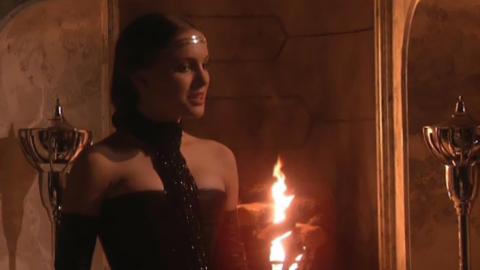 Anakin then spends the night moaning and twitching in his sleep, which he later explains is because he was dreaming of his mother. Hmmm. After his scant ten year absence, Ani decides it would be good to see ol’ mom, Shmi Skywalker, again–perhaps to get some of his capes washed. So, despite strict orders delivered in a convincing monotone by former actor Samuel Jackson, he and the young braless senator rush off to Tatooine. (The location budget on this film must have been extraordinary.)
Anakin then spends the night moaning and twitching in his sleep, which he later explains is because he was dreaming of his mother. Hmmm. After his scant ten year absence, Ani decides it would be good to see ol’ mom, Shmi Skywalker, again–perhaps to get some of his capes washed. So, despite strict orders delivered in a convincing monotone by former actor Samuel Jackson, he and the young braless senator rush off to Tatooine. (The location budget on this film must have been extraordinary.)
Meanwhile, in another movie, Obi-wan finds out something about a plot of some kind involving clones.
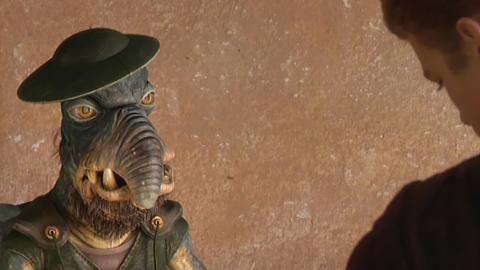 Ani and Ami arrive on Tatooine, where Ani meets his beloved former slave-master, the big Jewish insect Watto. (Did I mention Lucas should stop letting his kids name his characters?) Watto had sold Shmi to lonely, sweaty moisture farmer Cliegg Lars who “married” her (wink, wink). Our young heroes, along with plucky little R2D2, rush to Lars’s moisture farm where they meet–who else?–C3PO! (Amazing that back in Episode IV neither ‘droid remembered ever having been there. My bet is they have Microsoft operating systems.)
Ani and Ami arrive on Tatooine, where Ani meets his beloved former slave-master, the big Jewish insect Watto. (Did I mention Lucas should stop letting his kids name his characters?) Watto had sold Shmi to lonely, sweaty moisture farmer Cliegg Lars who “married” her (wink, wink). Our young heroes, along with plucky little R2D2, rush to Lars’s moisture farm where they meet–who else?–C3PO! (Amazing that back in Episode IV neither ‘droid remembered ever having been there. My bet is they have Microsoft operating systems.)
Alas, poor Anakin’s mom is not there. While she was out picking mushrooms–which I hear are common in lifeless desert locations–she was abducted by a bunch of horny Tusken Raiders. Well, Ani’s capes aren’t going to wash themselves, so he sets out to rescue her, and he succeeds admirably except for the fact she’s dead. This is a turning point for young Ani, at least to 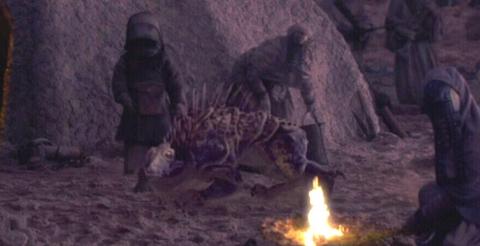 judge by the music, as he proceeds to slaughter (off-screen) the entire tribe of Tuskens, including their pet Rodents Of Unusual Size that had wandered over from the “Princess Bride” set.
judge by the music, as he proceeds to slaughter (off-screen) the entire tribe of Tuskens, including their pet Rodents Of Unusual Size that had wandered over from the “Princess Bride” set.
Meanwhile, in that other film, Obi-wan discovers a missing planet which holds the key to something. He arrives on the planet, a water-covered world buffeted by incessant rain, much like Seattle. He’s taken to meet the Prime Minister and finds out they’re manufacturing clones by the kajillion at the behest of bounty hunter “Boba Fett’s Dad.” Obi-wan promptly overstays his welcome by getting into a fight-to-the-death with Fett, which both manage to survive. Fett then flees to yet another planet, with Obi-wan in hot pursuit.
Back on Coruscant, the soon-to-be-evil Chancellor Palindrome needs only for one of the thousands of Senators to step up and request the Chancellor be given War Powers, enabling him to command his massed Army o’ Clones. Only one Senator is stupid enough to do this. (We should have known all along that Jar Jar would be the cause of this entire disaster.)
A blur of other things happens, involving some more planets. At about this point, Lucas writes himself into a corner: Amidala is in trouble and only R2D2 can save her. Due to bad placement by the prop manager, he’s too far away to help. Not to worry, because it turns out R2D2 CAN FLY! Yes! Just like the monstrous, Japanese rubber turtle Gamera (but with less plot consistency), R2D2 can spew fire from his appendages and hurtle himself across space like a rocket-powered garbage can! Seems like that could have come in handy during the first four Star Wars movies. 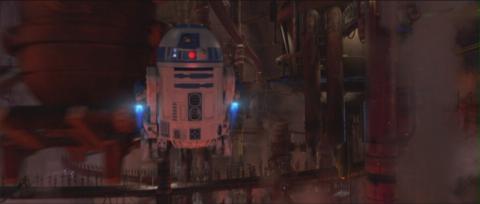
Ami, Ani, and Obi are captured by the evil simian dragonflies of Planet Somethingorother, under the command of Count Dooku. Ami admits to Anakin that she’s always been attracted to immature, delinquent jackasses, thus giving him a new reason to live. Count Saruman, er, Dooku, sentences them to death, and so they are handcuffed and dragged out to the center of a great coliseum to be summarily Executed By Critter.  Amidala picks her lock with her teeth and narrowly escapes being killed by a giant saber-toothed rat, which fortunately manages to tear the midriff from her outfit. Ani and Obi do a bunch of Jedi Chan gymnastics, narrowly outsmarting the mindless creatures trying to kill them. Dooku’s gigantic robot army is then sent in to try to kill them (guns have been outlawed on this liberal planet), resulting in a slapstick sequence involving C3PO that is the funniest thing this side of a Pauly Shore movie. (At this point, Threepio did deliver the movie’s best line: “What’s going on? I’m so confused! I want to go home!” To which I yelled, “Me and you both, Brother!”)
Amidala picks her lock with her teeth and narrowly escapes being killed by a giant saber-toothed rat, which fortunately manages to tear the midriff from her outfit. Ani and Obi do a bunch of Jedi Chan gymnastics, narrowly outsmarting the mindless creatures trying to kill them. Dooku’s gigantic robot army is then sent in to try to kill them (guns have been outlawed on this liberal planet), resulting in a slapstick sequence involving C3PO that is the funniest thing this side of a Pauly Shore movie. (At this point, Threepio did deliver the movie’s best line: “What’s going on? I’m so confused! I want to go home!” To which I yelled, “Me and you both, Brother!”)
Unfortunately for the bad guys, the Great Clone Army of the Republic, under the command of General Yoda H. Schwartzkopf, arrives just in time to keep the movie from slowing to something understandable. A vast amount of death and mayhem, suitable for children of all ages, ensues.
The movie reaches its anticlimactic climax in the great light-saber fight required by California law. Count Saruman easily defeats the hapless Ani and Obi using the same lighting bolt finger technique he mastered in The Fellowship of the Ring, but then must face Yoda. With the spine-tingling words, “You dark side evil have become yes!” Yoda whips out his own light-saber and sets upon the Count like a wind-up, spinning, wrinkled Muppet hopped up on goofballs.
 Ultimately, the good bad guys win, while the bad good guys get away (I think; by this point it was hard to know who to root for). For reasons never explained, Amidala marries Anakin and the movie ends–about two hours twenty-three minutes after it should have.
Ultimately, the good bad guys win, while the bad good guys get away (I think; by this point it was hard to know who to root for). For reasons never explained, Amidala marries Anakin and the movie ends–about two hours twenty-three minutes after it should have.
I generously rate it four vacuums. God knows how many it would have gotten if Natalie Portman had kept all her clothes on. (But to be fair, if you wanna see Celebrity Dominatrix done right, the crown still belongs to Diana Rigg!)
*Lest you think I’m kidding about the names, consider these babies: Lott Dod, Plo Koon, Orn Free (seriously), Ask Aak, Kit Fisto (probably stolen from a porn movie), Depa Billaba, Pooja and Ryoo Naberrie, Sio Bibble, and my personal favorites, Dexter Jettster, Nute Gunray, and Elan Sleazebaggo.
I wish I were kidding.
All Rights Reserved
A.I.










Gawdalmighty.
I rated Star Wars II: The Attack of the Clones four vacuums, but it was Citizen Kane compared to this abomination. This movie was the Gigantic Black Hole of Celluloid, sucking the talents of everyone involved into an abyss from which there is no escape. And in keeping with the laws of physics, time itself seemed to draw to a stop for the hapless viewer trapped in its clutches.
This was one of those rare movies that actually sucked before the opening credits. Staring at a black screen, we are held prisoner by an insipid lecture  on global warming that made Al Gore’s Inconvenient Truth feel like Rambo.
on global warming that made Al Gore’s Inconvenient Truth feel like Rambo.
Next we watch William Hurt (cast as “Professor Allen Hobby, The Visionary”) addressing a conclave of hostage library patrons, explaining the need for robot children, while elsewhere in the world a bereaved mommy (Mrs. Swinton) reads to her comatose child, humanely frozen in Sigourney Weaver’s cast-off hibernation pod from Alien.
Before you know it, her husband (one of Hurt’s employees), is dragging home the billion-dollar robo-brat prototype, cleverly disguised as Haley Joel Osment. Well, soon Mommy has forgotten all about her own kidsickle and has taken to “David” like a Democrat to a tax hike. Showing an inhuman lack of sensitivity, she reads Pinocchio to the tyke, presumably to reaffirm his self-identity as a soulless animatronic mechanoid. 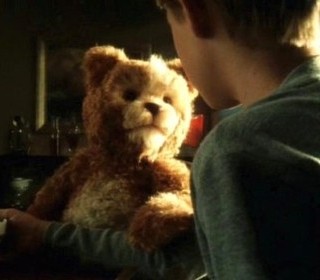 Borrowing from such powerful drama as Buck Rogers in the 25th Century, Spielberg here introduces a small android companion for David, named “Teddy”–sort of a cross between Fozzy Bear and Chucky.
Borrowing from such powerful drama as Buck Rogers in the 25th Century, Spielberg here introduces a small android companion for David, named “Teddy”–sort of a cross between Fozzy Bear and Chucky.
Well, who woulda thought that after years in a coma, the Swintons’ own son would pick now to go into defrost cycle and show up back home? In no time at all, Mrs. Swinton lovingly takes her darling prototype for a drive and, in her maternal compassion, abandons David in the woods like a pregnant alley cat.
From there things go from bad to unfathomably horrible. For the viewer, I mean. Jude Law, licensed ElectroSex android “Gigolo Joe,” is on the run from the law for a murder that was actually committed by a one-armed 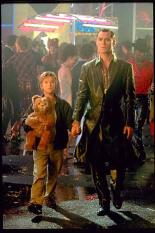 man. He befriends the cute, adorable, young David for reasons best left unsaid. The full moon rises, but actually is a hot air balloon, and a bunch of extras from The Running Man show up on their Harleys, which are disguised as wolves. Our intrepid heroes are rounded up to be dismembered before a rabid stadium full of Human Supremacists. The faithful Teddy wobbles into camp, where he is captured and–in a brilliant, single-cut sequence reminiscent of Orson Welles’s Touch of Evil, spanning a full minute or more of screen time, thousands of extras, and about a million dollars’ worth of production–is dropped off at lost-and-found, from which he gets up and walks away.
man. He befriends the cute, adorable, young David for reasons best left unsaid. The full moon rises, but actually is a hot air balloon, and a bunch of extras from The Running Man show up on their Harleys, which are disguised as wolves. Our intrepid heroes are rounded up to be dismembered before a rabid stadium full of Human Supremacists. The faithful Teddy wobbles into camp, where he is captured and–in a brilliant, single-cut sequence reminiscent of Orson Welles’s Touch of Evil, spanning a full minute or more of screen time, thousands of extras, and about a million dollars’ worth of production–is dropped off at lost-and-found, from which he gets up and walks away.
Unfortunately, David and Gigolo Joe escape destruction. David, using his positronic 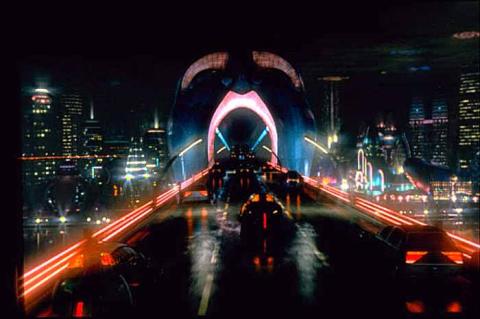 brain, deduces that if only he can find the Blue Fairy, he can become a real boy. The two make their way to Rouge City, a sort of Las Vegas without the understated charm, where they are pointed to Manhattan by a holographic Einstein (which should engender some kind of lawsuit from his descendants).
brain, deduces that if only he can find the Blue Fairy, he can become a real boy. The two make their way to Rouge City, a sort of Las Vegas without the understated charm, where they are pointed to Manhattan by a holographic Einstein (which should engender some kind of lawsuit from his descendants).
David goes to the destroyed, underwater metropolis and runs into, who else, Professor Hobby. Drawing from page fifteen of the Plot Convenience Handbook, the prof leaves David alone while he looks for some associates (who, perhaps due to budgetary limits, are offscreen). David then escapes and ends up underwater, trapped in front of the Coney Island Pinocchio ride, where he will stare at the Blue Fairy for all eternity. Well, it’s better than watching this DVD.
My wife dozed off at this point; when she awoke five minutes later and asked what she had missed, I told her, “Well, the global warming froze all the oceans, thousand of years elapsed, and some kind of scrawny aliens, or possibly androids, have taken over the world and are debriefing David.”
She thought I was kidding.
Spielberg now wrote an entire new chapter in the Plot Convenience Handbook by having the aliens explain to David that everything, including memories, are trapped in the fabric of space-time and that by using a sample of DNA they can reconstruct his full-grown mother, and he and she can be reunited. Well, only until she falls asleep, that is, at which point the space-time fabric forgets everything. (Don’t ask me; I didn’t write it.)
 So they bring her back, she hugs and lovie-cuddles David, reads him a bedtime story, and falls asleep, leaving David dead, comatose, or alone for all eternity–the movie wasn’t terribly clear on which.
So they bring her back, she hugs and lovie-cuddles David, reads him a bedtime story, and falls asleep, leaving David dead, comatose, or alone for all eternity–the movie wasn’t terribly clear on which. 
The film ended after a scant six or seven weeks, although the running time is officially listed at two hours twenty-six minutes.
I thought Haley Joel Osment was especially effective as the robot child yearning to be a real boy, perhaps drawing on his personal experience of feeling like a real actor trapped in the body of this film.
I rate it the entire Hoover production factory, but only because I’m in a good mood.
All Rights Reserved
Solaris










Plot Summary: George Clooney goes into space, maybe meets his wife, maybe comes back home. (Note to director Steven Soderbergh–it really doesn’t take a hundred minutes to tell that, now does it?)
Until I saw Solaris, I thought my college course AA597: Attitude Dynamics of Spacecraft was the most boring way to spend one’s time while still breathing. I was wrong. NOTHING HAPPENS IN THIS MOVIE! I thought someone had accidentally hit the A-B Repeat function on the remote, forcing us to choke on the same cinematic bile over and over. Ice ages have passed in less subjective time than Solaris.
The “plot” (haha) revolves around Clooney’s wife, who has committed suicide. By the movie’s halfway point, I deeply envied her. We learn about their life together through a couple hundred flashback scenes that are clearly meant to be gut-wrenching. In an ending that steals, er, borrows elements from The Sixth Sense, 2001: A Space Odyssey, and possibly Manos: The Hands of Fate, George gets her back. Or maybe not.
I wish I had more to say, but hey, I’ve already said more than Soderbergh managed in 9,000 feet of film.
Performances: George Clooney was himself, neither good nor bad, just there. 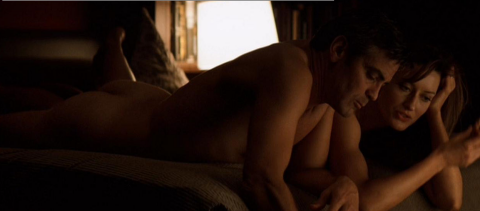 As was his ass, which figured prominently in many scenes. Soderbergh wrote the screenplay, but I’ll leave it to you to draw the inescapable conclusion.
As was his ass, which figured prominently in many scenes. Soderbergh wrote the screenplay, but I’ll leave it to you to draw the inescapable conclusion.
As Clooney’s wife, Natascha McElhone did a fine job showing off her DD implants. Don’t get too excited: they’re in her cheeks.
Jeremy Davies, the wimpy, conflicted guy from Saving Private Ryan, stretched his acting chops by playing a wimpy, conflicted guy with a beard.
Director Steven Clooney-Soderbergh obviously decided to team up with his favorite boy-toy, George, to make a movie that would cause us to look back on their Ocean’s Eleven collaboration with nostalgia. (It didn’t work.) In Solaris, Soderbergh demonstrates the maturity he is achieving at stealing other director’s techniques. He apparently filmed this movie after a sitting through a 2001: A Space Odyssey weekend marathon. (Another note to Soderbergh: weird music, dramatic cuts, and stark sets are not what made 2001 brilliant.)
In short, this was 99 minutes of excruciating, mind-numbing, narcoleptic-inducing agony. I thought A.I. would forever stand alone as the worst movie ever reviewed on this web site. I prayed for it in fact, offered sacrifices to the Gods of Celluloid that its equal would never slither from the demented bowels of Hollywood.
I was wrong.
All Rights Reserved
Reviews
Ancient Native American legends speak of a mythical location in Southern California that used to make worthwhile motion pictures. This was back in the dim past, before hundred-million dollar budgets, “script doctors,” and Ben Affleck. Today, we live in a world devoid of creativity, a world where banter and subtext have been replaced with flatulence and crushed testicles.
This site is refuge for all of you who are tired of reading reviews by elitist snobs beholden to their newspaper editors or television producers; reviewers who because of weak spines and fear of litigation will not tell you the bitter truth about This Week’s Openings; reviewers who actually know something about film.
For I am one of you. And I have had enough.
Spoiler alert: These reviews discuss actual scenes from the movies. Nearly all the scenes, in fact. Do not read on a full stomach.
(NOTE: You can follow me on Twitter @ExNASATerry)